مشروع دعم حديقة السطح العلويّة للمباني الخاصة.
Background
The highly urbanized modern cities are suffering from the problems caused by the increasing heat island effects especially in the dense downtown area. While the annual average temperature is getting higher because of the greenhouse effect, the heat island effect makes the city temperature raised more and accordingly the energy use in the buildings is getting increased. It is necessary to take proper measures for the increasing urban temperature and for the improvement of energy efficiency. As highest is the proportion of energy consumption in buildings in particular, management of temperature increase of buildings and energy control are needed.
Most of the surface areas of the buildings in downtown are covered with concrete and cement. Thus, surface enhancement of the buildings is an important means to mitigate the urban heat island effects. Seoul has made several attempts to create and expand the green spaces. Roof gardening and wall greening are parts of green space expansion projects that Seoul has actively promoted. Especially the roof gardening can lower the temperature inside the buildings in the microclimate aspect resulting in relaxation of the urban heat island effects. The necessity of roof gardening is getting higher because it reduces the amount of energy use in the buildings and the rainwater run-off rate by lowering the heat flow rate.
<Figure 1> Satellite Pictures of Heat Island EffectsMost of the surface areas of the buildings in downtown are covered with concrete and cement. Thus, surface enhancement of the buildings is an important means to mitigate the urban heat island effects. Seoul has made several attempts to create and expand the green spaces. Roof gardening and wall greening are parts of green space expansion projects that Seoul has actively promoted. Especially the roof gardening can lower the temperature inside the buildings in the microclimate aspect resulting in relaxation of the urban heat island effects. The necessity of roof gardening is getting higher because it reduces the amount of energy use in the buildings and the rainwater run-off rate by lowering the heat flow rate.
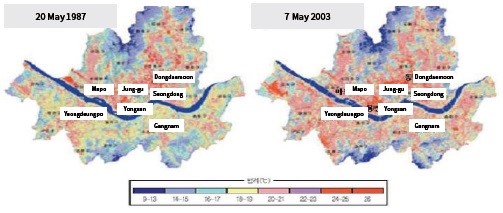
Heat Island Mitigating Effects of Roof Gardening
The roof gardening project is well worth enough in that it is possible to secure the neighborhood green spaces more in the downtown area without separate land compensation. It is also effective in mitigating the urban heat island phenomenon, expanding the habitat spaces for plants and in improving air quality.
The roof gardening creates shade on the building surface. The soil for tree planting prevents the direct touch of sunlight on the surfaces of buildings. The shade lowers the surface temperature and reduces the heat transfer to the inside of buildings. Accordingly, the heat emitted to the air again is reduced to lower the temperature around the buildings. The surface temperature of the buildings with the green spaces is measured to be lowered by 11~25℃ in maximum. A study says the surface temperature of the wall greening buildings is lowered by 20℃ in maximum. In addition, the rainwater stored in soil lowers the temperature of buildings or areas surrounding them in the process of evaporation or evapotranspiration by vegetation. While the general roof tops without gardens release 95% of the solar radiation energy to the air in number, the solar radiation energy is reduced by 58% through evapotranspiration process in case of the roof tops with gardens, resulting in mitigation of the urban heat island effects.
The roof gardening creates shade on the building surface. The soil for tree planting prevents the direct touch of sunlight on the surfaces of buildings. The shade lowers the surface temperature and reduces the heat transfer to the inside of buildings. Accordingly, the heat emitted to the air again is reduced to lower the temperature around the buildings. The surface temperature of the buildings with the green spaces is measured to be lowered by 11~25℃ in maximum. A study says the surface temperature of the wall greening buildings is lowered by 20℃ in maximum. In addition, the rainwater stored in soil lowers the temperature of buildings or areas surrounding them in the process of evaporation or evapotranspiration by vegetation. While the general roof tops without gardens release 95% of the solar radiation energy to the air in number, the solar radiation energy is reduced by 58% through evapotranspiration process in case of the roof tops with gardens, resulting in mitigation of the urban heat island effects.
<Figure 2> Process of Mitigating Heat Island Effects by Roof Gardening

According to the results of the relevant studies, the surface temperature of the buildings with roof gardening applied is lower than that of concrete by 32℃ in maximum in summer, which shows the effectiveness of roof gardening in mitigating the heat island phenomenon. Even with the vegetation covering by the light weight roof gardening, satisfactory temperature reducing effect can be obtained.
<Table 1> Existing Studies and the Temperature Reducing Effect of Roof Gardening
| Literature | Applied Type | Classifications | Time | Temp. Difference between the Surfaces of Roof Garden and Concrete |
Temp. Difference between the Ceiling Surfaces with Roof Garden and without it |
|---|---|---|---|---|---|
| Hyun-su Kim and Others(1999) | Light weight | Depth of Soil 9.6㎝+ Vegetation | Daily Maximum in Summer | -16℃ | |
| Young-hwan Song(2001) | Light weight | Depth of Soil 20㎝+No Vegetation | Daily Maximum in Summer | -5.5℃ | -6.7 |
| Sang-tae Lee, Jin-seon Kim (2004) | Light weight | Vegetation Block 10㎝+Soil Addition 1㎝ | Daily Maximum in Summer | -16.4℃ | -1.2 |
| Vegetation Block 10㎝+Soil Addition 1㎝ | Daily Maximum in Winter | +1.7℃ | +4.1 | ||
| Dong-geun Lee and others (2005) | Light weight | Depth of Soil 10㎝+ Vegetation Depth of Soil 20㎝+ Vegetation |
Daily Maximum in Summer | -3.7~8.4℃ | Max. -2.4 Average -1.3 |
| Seung-hwan Oh (2007) | Light weight | Depth of Soil 10㎝, No Vegetation | Daily Maximum in Summer | -9.3℃ | |
| Depth of Soil 10㎝, Vegetation | -21.1℃ | ||||
| Depth of Soil 15㎝, Vegetation | -22.0℃ | ||||
| Depth of Soil 20㎝, Vegetation | -22.7℃ | ||||
| Won-ju Kim (2009) | Heavy weight | Soil + Multi-layer Vegetation | Daily Maximum in July and August | -32.0℃ | |
| Maximum in July | -17.4℃ |
Environmental Effects of Roof Gardening
In addition to the effect of mitigating the urban heat island phenomenon, roof gardening has several positive effects in terms of environment. Because of the city surfaces paved with the impermeable materials such as concrete and asphalt, the amount of rainwater directly flowed into the sewage system has increased to cause flooding in the cities. Roof gardening is effective in preventing the urban flooding by reducing the impermeable spaces, storing rainwater for a while and reducing rainwater outflow. Also, roof gardening provides the urban environment with green space by which the habitat space can be secured and the urban ecosystem can be restored. The soil layer created through roof gardening absorbs sound waves to reduce noise. The gardens absorb carbon dioxide, sulfur dioxide gas, nitrogen compounds, benzene, dusts and heavy metals and emit oxygen to bring the effect of air purification.
Economic and Social Effects of Roof Gardening
The soil layer made by roof gardening protects the waterproof layer of the buildings, prevents the concrete from being deteriorated by acid rain and the ultraviolet rays and accordingly improves the durability of the structures. Thanks to the mixed effects of solar radiation blocking, latent heat by the evapotranspiration of the vegetation area and the physical insulation by the soil layer, the heat conductivity gets lower than the other roofs without gardens and the significant effect on the building cooling and heating and energy saving can be brought. The obligatory landscaping space on the ground can be replaced with the roof gardening area while securing the green spaces in the cities and improving the quality of environment and landscape. The buildings with good roof gardening can expect higher rental income because they have comfortable green spaces.
Roof gardening can improve the city landscape as well as the appearance of buildings by creating green spaces on the roofs and shielding the poor roof landscapes. The deserted roof can be used as a space for rest, recreation, education or urban agriculture cultivating various vegetables and fruits. The newly created spaces can give spiritual comfort to the people and ultimately enhance the comfort of residential environment.
Investigation on Awareness of Roof Gardening
According to investigation results, awareness on and requests for the environmental functions and the necessity of roof gardening was high. More citizens demanded roof gardening for the buildings where they live. However, concerns about the burden of the costs necessary for the installation of roof gardens, difficulties of follow-up management and safety of buildings were analyzed as the factors to hinder the activation of roof gardening.
<Table 2> Effects of Roof Gardening
| Environmental Effects | Reduction of Environmental Pollution |
|
Direct Effects |
| Restoration of Urban Ecosystem |
|
||
| Climate Modification |
|
||
| Ecological & Psychological Effects |
|
||
| Economic Effects |
Energy Saving Cost KRW 164.48 billion KRW 188.4 billion KRW 253.32 billion Energy saving effect of in air conditioning and heating (TOE)
|
Direct Effects | |
| Realization of Low Environmental Load Regions |
|
Effects of Realization of Sustainable Regions | |
| Realization of Recycling Cities and Regions |
|
||
| Realization of Cities and Regions Coexisting with Nature |
|
||
Potential
The total area of Seoul is 605km² of which the urbanized area is 364km² taking 60% of the entire area. The rooftop area reaches 166km² taking 46% of the total urbanized area. The available area for the diffusion roof gardening is estimated 55km², meaning the roof garden has potential for utilization of city space.
History
Roof Gardening Project
To activate roof gardening, Seoul facilitated a project named “Creation of 100,000 Green Roofs” in cooperation with the Green Seoul Citizen Committee. The project began in earnest with designating 32,172m²(9,732 pyeong) in 55 places as the priority project objects. Seoul had created roof gardens on around 130 public and private constructions from 2000 to 2007. Seoul established a short-term plan to secure the area of 100,000 pyeong for roof gardening by 2010.
In the beginning stage, new buildings completed within 10 years were allowed to participate in the project but all buildings over 99㎡(30 pyeong) in area with structural safety secured could join the project from 2007. Priority was given to the buildings with easy access of the citizens, the multiple-use buildings with high public nature and the constructions in the regions with insufficient parks & landscape like the downtown area.
In the beginning stage, new buildings completed within 10 years were allowed to participate in the project but all buildings over 99㎡(30 pyeong) in area with structural safety secured could join the project from 2007. Priority was given to the buildings with easy access of the citizens, the multiple-use buildings with high public nature and the constructions in the regions with insufficient parks & landscape like the downtown area.
Beginning of Roof Gardening Project
Seoul started again the roof gardening project for the public buildings to lead the roof gardening for the private buildings and created 3,348m² in 4 places. Seoul also has increased the supply rate of roof gardening through roof garden academy, monitoring, planning and promotion to convey the roof gardening technology and information on maintenance. Seoul introduced matching fund method to activate the roof gardening for the private buildings. It invested KRW 2.8 billion for 5 years from 2002 to support the roof gardening projects and created 17,680m² of green spaces in 46 places by 2006.
Plans and Support Expenses of Roof Gardening Project
Following the roof gardening for the public buildings, Seoul facilitated the roof gardening for the viewing areas from Namsan where a lot of tourist and citizens used to visit to improve the city appearance, to meet the public interest and request and to expand roof gardening. In March 2007, 128 private buildings applied for the roof gardening support. Through the deliberation of the 「100,00 Green Roof Promotion Committee」 consisting of civilians, the area of 26,238m² in 36 places including Nasvil Building in Jongno was selected as the project buildings. Seoul supported around 50% of the costs for design and construction for the selected buildings unless they have special problems after the safety inspection by the relevant service companies.
Seoul established roof gardening plan in 2011. The total budget was KRW 11,229 million of which KRW 7,706 million was for the public buildings and KRW 3,523 million was for the private buildings. Of the budget for the public buildings, KRW 4,654 million was for facility construction, KRW19 million was for facility and additional cost and KRW 3,033 million was for subsidies to support the capital of autonomous districts. In case of private buildings, the buildings which has more than 99m² of roof gardening area were allowed to apply for the project to get the expense support. KRW 2,920 million was planned to support the private capital, KRW 6 million for office management and KRW 3 million for administrative works. Additional apply of around 13,000m² area was made as the object of the project in 2011 and Seoul paid around KRW 3~5 million for the building safety diagnosis per building.
In case of the public buildings, Seoul supported the total costs for the city owned buildings. For the other buildings, support was made if the building owners take over 30% of the total project cost.
In case of private buildings, the rate of support is different depending on whether they are in the viewing areas from Namsan or not. For the roof gardening facilitation area in the visible distance from Namsan, 70% of design and construction costs were supported, KRW 126,000/m² for the light weight structure in maximum and KRW 150,000/m² for the mixed or heavy weight structure. For the other areas, 50% of the design and construction costs were supported. Roof gardening for the private buildings reached 102 buildings in 2009. In case of supporting 50% of the design and construction costs, KRW 90,000//m² for the light weight structure mainly with grass and flowers and KRW 108,000 for the mixed or heavy weight structure mainly with planting of trees and resting places were paid as subsides.
Seoul established roof gardening plan in 2011. The total budget was KRW 11,229 million of which KRW 7,706 million was for the public buildings and KRW 3,523 million was for the private buildings. Of the budget for the public buildings, KRW 4,654 million was for facility construction, KRW19 million was for facility and additional cost and KRW 3,033 million was for subsidies to support the capital of autonomous districts. In case of private buildings, the buildings which has more than 99m² of roof gardening area were allowed to apply for the project to get the expense support. KRW 2,920 million was planned to support the private capital, KRW 6 million for office management and KRW 3 million for administrative works. Additional apply of around 13,000m² area was made as the object of the project in 2011 and Seoul paid around KRW 3~5 million for the building safety diagnosis per building.
In case of the public buildings, Seoul supported the total costs for the city owned buildings. For the other buildings, support was made if the building owners take over 30% of the total project cost.
In case of private buildings, the rate of support is different depending on whether they are in the viewing areas from Namsan or not. For the roof gardening facilitation area in the visible distance from Namsan, 70% of design and construction costs were supported, KRW 126,000/m² for the light weight structure in maximum and KRW 150,000/m² for the mixed or heavy weight structure. For the other areas, 50% of the design and construction costs were supported. Roof gardening for the private buildings reached 102 buildings in 2009. In case of supporting 50% of the design and construction costs, KRW 90,000//m² for the light weight structure mainly with grass and flowers and KRW 108,000 for the mixed or heavy weight structure mainly with planting of trees and resting places were paid as subsides.
Budget Securing for Roof Gardening
To facilitate roof gardening, Seoul has tried to improve institutions by suggesting the revision of Building Act and to secure the budget to support the citizens. Seoul had applied for a contest for green funds (lottery funds) of the Korea Forest Service to receive KRW 675 million which was used for the roof gardening of the 6 public buildings with 2,090m² in area including Eunpyeong Municipal Hospital. The money was provided by the green fund operated by the green fund management group under the Korea Forest Service for the area of “City Forest Creation”. It meant that the roof gardening project of Seoul was externally recognized and admitted to have the ecological effects and values.
In systematic and organic cooperation with the Green Seoul Citizen Committee, the Korea Association of Artificial Ground Greening, presses, enterprises, academies, civic groups, etc., Seoul has facilitated the roof gardening campaign named “Creation of 100,000 Green Roofs”.
In systematic and organic cooperation with the Green Seoul Citizen Committee, the Korea Association of Artificial Ground Greening, presses, enterprises, academies, civic groups, etc., Seoul has facilitated the roof gardening campaign named “Creation of 100,000 Green Roofs”.
Results
Seoul started the roof gardening project from 2002 and had created roof gardens in 661 places (278,242㎡) until 2013 by investing KRW 59,338 million. The roof gardening project was resulted in bring about several positive effects. Thanks to 60~70% of solar radiation reduction, roof gardening lowered the surface temperature of buildings and suppressed temperature rise to save energy. Also, it took the role of ecological stepping stones in the city center and provided the space for relaxation, leisure and environmental education of the citizens.
<Table 3> Result of Roof Gardening Creation and Budget Amount
| Year of Creation | Budget (KRW Million) | Amount of Creation (Places, Areas) | ||||
| Total | Private | Public | Total | Private | Public | |
| Total | 59,338 | 24,059 | 35,269 | 661 Places 278,242㎡ |
386 Places 148,898㎡ |
275 Places 129,344㎡ |
| 2002 | 640 | 640 | - | 11 Places 5,455㎡ |
11 Places 5,455㎡ |
- |
| 2003 | 640 | 640 | - | 10 Places 3,322㎡ |
10 Places 3,322㎡ |
- |
| 2004 | 320 | 320 | - | 9 Places 2,670㎡ |
9 Places 2,670㎡ |
- |
| 2005 | 430 | 280 | 150 | 6 Places 3,970㎡ |
6 Places 3,970㎡ |
(Commenced in 2005 & Completed in 2006) |
| 2006 | 580 | 280 | 300 | 14 Places 5,611㎡ |
10 Places 2,263㎡ |
4 Places 3,348㎡ |
| 2007 | 5,588 | 1,783 | 3,805 | 62 Places 24,154㎡ | 25 Places 11,218㎡ |
37 Places 12,936㎡ |
| 2008 | 12,323 | 4,803 | 7,520 | 106 Places 59,221㎡ |
64 Places 33,297㎡ |
42 Places 25,924㎡ |
| 2009 | 9,662 | 3,323 | 6,339 | 120 Places 47,001㎡ |
73 Places 25,091㎡ |
47 Places 21,910㎡ |
| 2010 | 11,229 | 3,323 | 7,906 | 108 Places 49,838㎡ |
59 Places 23,061㎡ |
49 Places 26,777㎡ |
| 2011 | 8,810 | 5,585 | 3,225 | 101 Places 40,649㎡ |
55 Places 21,219㎡ |
46 Places 19,430㎡ |
| 2012 | 5,010 | 2,350 | 2,650 | 69 Places 22,515㎡ |
50 Places 13,541㎡ |
19 Places 8,974㎡ |
| 2013 | 4,106 | 732 | 3,374 | 45 Places 13,836㎡ |
14 Places 3,791㎡ |
31 Places 10,045㎡ |
Seoul held an event at the “Choroktteul (meaning the Green Garden)” which had created on the roof of the Seoul City Hall Seosomun Annex. Through the Green Garden tour with commentary, Seoul explained cautions in design and construction of roof gardening and maintenance methods and promoted roof gardening project. Especially in 2006, the kindergarten students and children accompanied by their parents, general citizens and neighboring office workers were invited to the green garden tour with commentary to see and feel the wildflowers and scent of grass in the heart of Seoul. The Green Garden was created in the area of 300m²(around 90 pyeong) in 2000 as a pilot project. In 2007, there are around 120 kinds of plants including 43 kinds pf planted wildflowers, naturally grown dandelion and evening primrose, etc. and around 40 kinds of insects such as beetles, crickets, etc.
|
<Figure 4> Green Garden of Seoul City Hall Annex
 |
<Figure 5> Green Garden Tour with Commentary
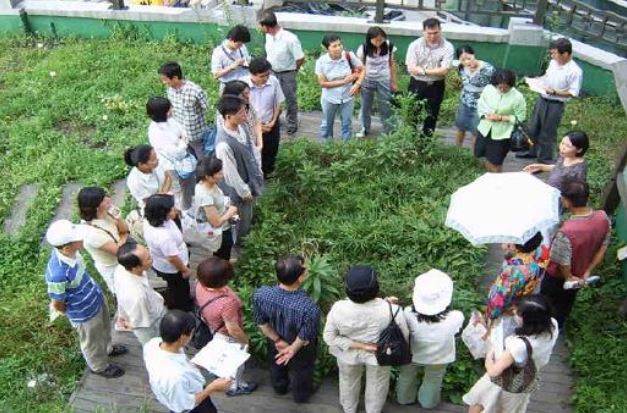 |
The roofs gardening project was applied to the public buildings like the public offices and the public parking lots starting Chung-gu Community Health Center in 2004 and followed by the Beoti public parking lot, the Jangchung public parking lot, Sindang 3-dong public parking lot, Gwanghui-dong Community Service Center, Sindang 6-dong public parking lot, Sindang 6-dong Community Service Center, Dongsan public parking lot, the workplace childcare center of Jung-gu Office, etc. The roofs of Jungbu Police Station, Jungbo Tax Office, Seoul Electric Power Transmission Center of KEPCO (Korea Electric Power Corporation) and National Theater are known to have beautiful gardens thanks to the roof gardening project of Seoul.
|
<Figure 6> Roof of the Jung-gu Public Parking Lot
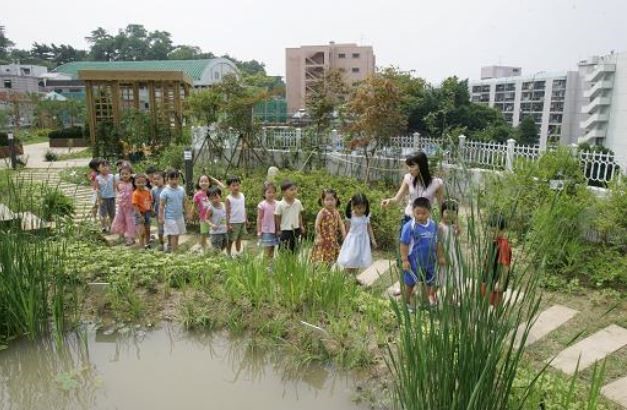 |
<Figure 7> Korea Testing and Research Institute for Chemical Industry
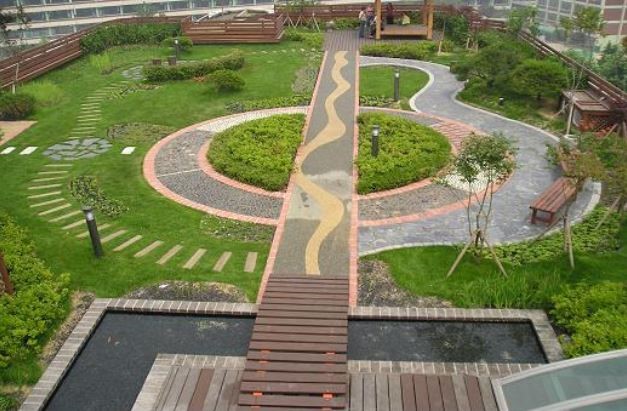 |
|
<Figure 8> Roof of the Gangnam-gu Office
 |
<Figure 9> Wolgok Social Welfare Center
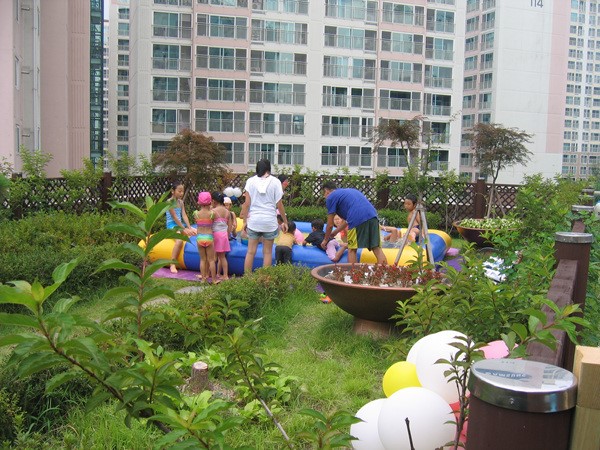 |
In case of the private buildings, roof gardening was made for the Sangrokwon of Dongguk University and the Shinsegae main buildings in 2005, Kukdo Hotel and Gyeseong Girls High School in Myeongdong in 2007. Seoul and Jung-gu Office supported 70% of the construction cost for the private buildings in Hoehyeon-dong, Myeongdong, Pil-dong, Jangchung-dong and a part of Sindang 2-dong which were the in the viewing range of Namsan. Seoul also supported the cost for the construction of private buildings including the Sangah building in Hoehyeon-dong, Hakrim building/Manhae building/Dongguk Building/Student Center/Hyehwa building/Academic and Cultural Center of Dongguk University, Taepyeongro Center (Taepyeongro 1-ga) of Choseon Media, Han Suites Building (Yejang-dong), Star Building (Pil-dong 1-ga), Shinyoung Building (Chungmuro 1-ga), Songye Building (Sindang 2-dong), etc.
|
<Figure 10> Roof of the Korea UNESCO Center
 |
<Figure 11> Bethel Montessori Nursery School
 |
|
<Figure 12> Roof of the Dongguk Building of Dongguk University
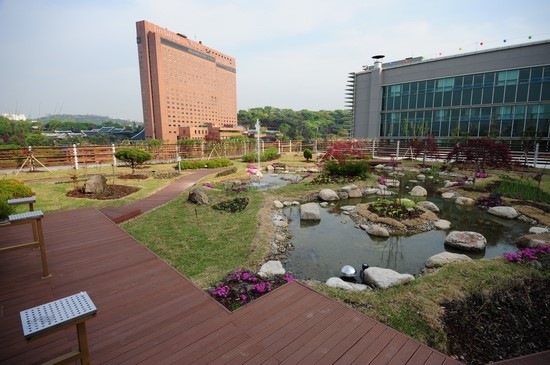 |
<Figure 13> Roof of the Student Hall of Dongguk Univesity
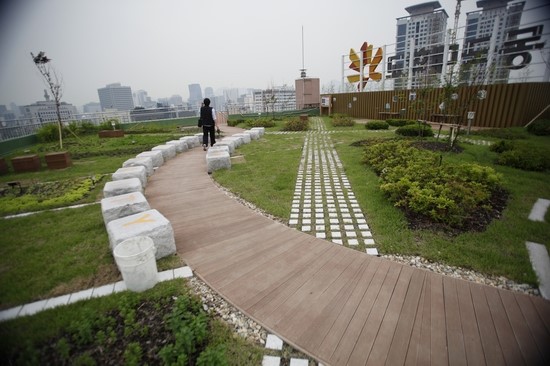 |
Awards
Award of “Administration Area” in the 1st Korea Artificial Greening Prize” (23 Feb. 2010)
The Roof Garden of Dongguk University was awarded the best “Gold” prize in the World Best Roof Garden Award of the Shanghai World Roof Gardening Contest (8 May 2010)
“Achievement Award” of the Korea Artificial Greening Association (28 Feb. 2013)
References
Seungho-Gil, 2010, Study on the Evaluation after Creation of Roof Gardens Supported by the Seoul City, Seoul National University
Won-ju Kim, 2008, “Activation Plan and Monitoring of Roof Gardening for Energy Saving”, Seoul Development Institute
Eunjin-Park, 2010, “Method to Activate Roof Gardening for Mitigation of Urban Heat Island Effects”, Gyeonggi Research Institute
Environment of Seoul: White Paper on Environment 2006, the Seoul Metropolitan Government
The Seoul Metropolitan Government, 2011, Policy Kit on the Roof Gardening Project in 2011, Green City Division, Seoul
The Seoul Metropolitan Government, Roof Gardening and Vegetable Garden Development Project, Green City Division, Seoul